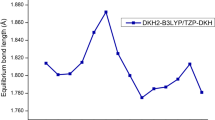Abstract
The reliability of the small-core lanthanide effective core potentials (ECP) is tested using MF and MF\(_3\), for M=Eu, Gd, Tb, and Yb and the atomic excitation energies for Pr, Nd, Eu, Gd, Tb, Dy, Ho, Er, Tm, and Yb. In some case, the ECP and all-electron (AE) results are in good agreement, while in others there are significant differences. The differences are much larger when the segmented basis set is used in conjunction with the ECP than when the atomic natural orbital (ANO) basis set is used. The study of the atoms suggests that problems for lanthanide-containing molecules are associated with poor atomic excitation energies in the ECP treatment and even using the ANO basis set does not completely solve the problem. We note that the problem appears to be more severe for density functional approaches than for traditional correlation methods. We suggest that additional studies and new effective core potentials may be required for the lanthanide atoms.
Similar content being viewed by others
References
Nguyen Q, Bauschlicher CW, Myers DL, Jacobson NS, Opila EJ (2017) Computational and experimental study of thermodynamics of the reaction of titania and water at high temperatures. J Phys Chem A 121:9508–9517
Stephens PJ, Devlin FJ, Chabalowski CF, Frisch MJ (1994) Ab initio calculation of vibrational absorption and circular dichroism spectra using density functional force fields. J Phys Chem 98:11623–11627
Becke AD (1993) Density-functional thermochemistry. III. The role of exact exchange. J Chem Phys 98:5648–5652
Bartlett RJ (1981) Many-body perturbation theory and coupled cluster theory for electron correlation in molecules. Annu Rev Phys Chem 32:359–401
Knowles PJ, Hampel C, Werner H-J (1993) Coupled cluster theory for high spin, open shell reference wave functions. J. Chem. Phys. 99:5219–5227. (See also (2000) Erratum: Coupled cluster theory for high spin, open shell reference wave functions. J Chem Phys 112:3106–3107
Raghavachari K, Trucks GW, Pople JA, Head-Gordon MA (1989) A fifth-order perturbation comparison of electron correlation theories. Chem Phys Lett 157:479–483
Bauschliche CW, Bodenschatz C, Myers DL, Jacobson NS (2020) Thermodynamics of high-temperature aluminum, zirconium, and yttrium hydroxide and oxyhydroxide vapor species. J Am Ceram Soc 103:5870–5880
Bauschlicher CW, Jacobson NS (2021) Thermochemistry of ytterbium and gadolinium hydroxides and oxy-hydroxides. J Phys Chem A 125:2913–2922
Dykstra CE (1977) Examination of brueckner condition for selection of molecular-orbitals in correlated wavefunctions. Chem Phys Lett 45:466–69
Dolg M, Stoll H, Preuss H (1989) Energy-adjusted ab initio pseudopotentials for the rare earth elements. J Chem Phys 90:1730–1734
Cao X, Dolg M (2002) Segmented contraction scheme for small-core lanthanide pseudopotential basis sets. J Molec Struct Theochem 581:139–147
Cao X, Dolg M (2001) Valence basis sets for relativistic energy-consistent small-core lanthanide pseudopotentials. J Chem Phys 115:7348
Lu Q, Peterson KA (2016) Correlation consistent basis sets for lanthanides: the atoms La-Lu. J Chem Phys 145:054111
Dunning TH (1989) Gaussian basis sets for use in correlated molecular calculations. I. The atoms boron through neon and hydrogen. J Chem Phys 90:1007–1023
Woon DE, Dunning TH (1993) Gaussian basis sets for use in correlated molecular calculations. III. The atoms aluminum through argon. J Chem Phys 98:1358–1371
Wolf A, Reiher M, Hess BA (2002) J Chem Phys 117:9215
Frisch MJ, Trucks GW, Schlegel HB, Scuseria GE, Robb MA, Cheeseman JR, Scalmani G, Barone V, Petersson GA, Nakatsuji H, et al. (2016) Gaussian 16, Revision A.03, Gaussian, Inc., Wallingford CT
Fang Z, Lee Z, Peterson KA, Dixon DA (2016) Use of improved orbitals for CCSD(T) calculations for predicting heats of formation of group IV and group VI metal oxide monomers and dimers and UCl 6. J Chem Theory Comput 12:583–3592
Werner H-J, Knowles PJ, Knizia G, Manby FR, Schütz M, Celani P, Györffy W, Kats D, Korona,T, Lindh R, MOLPRO, et al (2015) version 2015.1, a package of ab initio programs, see http://www.molpro.net. N.b. some of the spin-orbit calculations were performed using an old version, since we had the source and could increase the dimensions required for the larger spin orbit calculations
https://physics.nist.gov/PhysRefData/Handbook/atomic_number.htm
Huber KP, Herzberg G (1979) Molecular Spectra and Molecular Structure: IV Constants of Diatomic Molecules. Van Nostrand Reinhold Company, New York
Hauge RH, Hastie JW, Margrave JL (1971) Force constants and geometries of matrix isolated rare-earth trifluorides. J Less-Common Metals 23:359–365
Hastie JW, Hauge RH, Margrave JL (1975) Geometries and entropies of metal trifluorides from infrared spectra: ScF\(_3\), YF\(_3\), LaF\(_3\), CeF\(_3\), NdF\(_3\), EuF\(_3\), and GdF\(_3\). J Less-Common Metals 39:309–334
Funding
This work was supported by NASA’s Transformative Aeronautics Concepts Program as a part of the Transformative Tools and Technologies Project. Resources supporting this work were provided by the NASA High-End Computing (HEC) Program through the NASA Advanced Supercomputing (NAS) Division at Ames Research Center.
Author information
Authors and Affiliations
Corresponding author
Ethics declarations
Conflict of interest
The author declare no conflicts of interests.
Additional information
Publisher's Note
Springer Nature remains neutral with regard to jurisdictional claims in published maps and institutional affiliations.
Supplementary Information
Below is the link to the electronic supplementary material.
Rights and permissions
About this article
Cite this article
Bauschlicher, C.W. The reliability of the small-core lanthanide effective core potentials. Theor Chem Acc 141, 11 (2022). https://doi.org/10.1007/s00214-022-02867-9
Received:
Accepted:
Published:
DOI: https://doi.org/10.1007/s00214-022-02867-9




